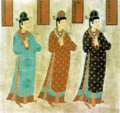Fashion in Western Xia

The founder of Western Xia (1038–1227 AD), Emperor Jingzong, established an apparel system which were characterized by the Tangut people's culture; the apparel system was established for all civil and military officials.[1][2] The Han Chinese-style and the Tangut-style clothing were distinguished from each other, but both were used in the Western Xia.[1] Emperor Jingzong also ordered that every people in Western Xia must be shaved in an attempt to restore old Xianbei customs, and disobedience was death penalty.[2]
Clothing of Emperors[]
The emperor of Western Xia wore round-collar gown with dragons roundels, high hats, and wore a belt over their gown.[2]
Clothing of government officials[]
Emperor Jingzong rejected Han Chinese silk clothing over the leather-based and wool clothing of the nomadic people from the Steppe; he argued that the Tanguts had traditionally worn leather-based and wool clothing and since the Tanguts men were military, they also had no use of silk materials.[1] Yet, silk clothing was still worn in Western Xia during his reign.[1]
The Han-style clothing was worn by officials whereas the Tangut-style clothing was worn by the military.[1] Civil officials wore futou, boots, purple or crimson gown.[2] Envoys of Western Xia were always dressed in narrow gown and wore golden diexie, leather boots, and golden hats.[2] However, in 1061 AD, Emperor Yizong, the son of Emperor Jingzong, decided to replace Tangut clothing with Han Chinese clothing in his court.[3] In his wish list to the Song dynasty court, Emperor Yizong asked permission to use Han Chinese rites and clothing to greet Song dynasty envoys and seek permission to buy Chinese official clothing; both of these requests were granted.[3]
Clothing of servants[]
Servants wore round-collared, narrowed-sleeved gowns of various colours which was decorated with roundels and fastened their gown with a waistband.[2]
Clothing of women[]
The women in Western Xia wore skirts and embroidered narrow-sleeved, cross-collared gowns which tend to be made of coarse cloth, fine wool, and animal hides.[2]
Gallery[]

Tangut Emperor and a boy, a Western Xia Painting, 13th century.

Sitting figures, Western Xia painting, 13th century.

Mural depicting women wearing a cross-collared gown and skirts; Western Xia.

Mural depicting men; Western Xia.

Face of Western Xia official

Western Xia official

Western Xia woman

Western Xia woman
See also[]
References[]
- ^ a b c d e Shea, Eiren L. (2020). Mongol court dress, identity formation, and global exchange. New York, NY. p. 15. ISBN 978-0-429-34065-9. OCLC 1139920835.
- ^ a b c d e f g Zhu, Ruixi; Zhang, Bangwei; Liu, Fusheng; Cai, Chongbang; Wang, Zenyu (2016). A social history of middle-period China : the Song, Liao, Western Xia and Jin dynasties. Cambridge, United Kingdom: Cambridge University Press. pp. 32–59. ISBN 978-1-107-16786-5. OCLC 953576345.
- ^ a b Dunnell, Ruth W. (1996). The great state of white and high : Buddhism and state formation in eleventh-century Xia. Honolulu: University of Hawai'i Press. ISBN 0-585-34402-7. OCLC 47010540.
- Western Xia
- Dynasties in Chinese history
- Former countries in Chinese history
- Former empires
- Tangut history
- Chinese clothing
- History of Asian clothing







